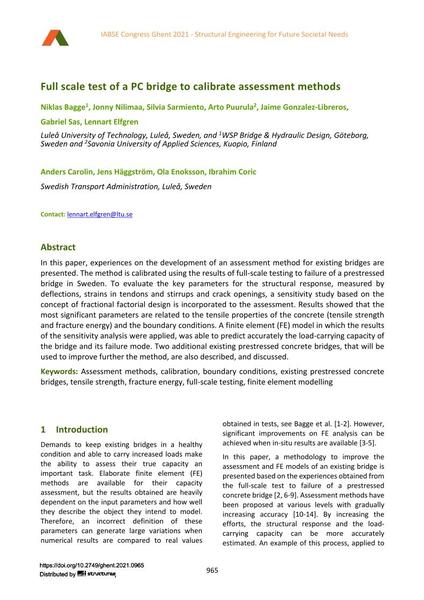Full scale test of a PC bridge to calibrate assessment methods

|
|
|||||||||||
Bibliographic Details
| Author(s): |
Niklas Bagge
Jonny Nilimaa (Luleå University of Technology, Luleå, Sweden) Silvia Sarmiento (Luleå University of Technology, Luleå, Sweden) Arto Puurula (Luleå University of Technology, Luleå, Sweden; Savonia University of Applied Sciences, Kuopio, Finland) Jaime Gonzalez-Libreros (Luleå University of Technology, Luleå, Sweden) Gabriel Sas (Luleå University of Technology, Luleå, Sweden) Lennart Elfgren Anders Carolin (Swedish Transport Administration, Luleå, Sweden) Jens Häggström (Swedish Transport Administration, Luleå, Sweden) Ola Enoksson (Swedish Transport Administration, Luleå, Sweden) Ibrahim Coric (Swedish Transport Administration, Luleå, Sweden) |
||||
|---|---|---|---|---|---|
| Medium: | conference paper | ||||
| Language(s): | English | ||||
| Conference: | IABSE Congress: Structural Engineering for Future Societal Needs, Ghent, Belgium, 22-24 September 2021 | ||||
| Published in: | IABSE Congress Ghent 2021 | ||||
|
|||||
| Page(s): | 965-973 | ||||
| Total no. of pages: | 9 | ||||
| DOI: | 10.2749/ghent.2021.0965 | ||||
| Abstract: |
In this paper, experiences on the development of an assessment method for existing bridges are presented. The method is calibrated using the results of full-scale testing to failure of a prestressed bridge in Sweden. To evaluate the key parameters for the structural response, measured by deflections, strains in tendons and stirrups and crack openings, a sensitivity study based on the concept of fractional factorial design is incorporated to the assessment. Results showed that the most significant parameters are related to the tensile properties of the concrete (tensile strength and fracture energy) and the boundary conditions. A finite element (FE) model in which the results of the sensitivity analysis were applied, was able to predict accurately the load-carrying capacity of the bridge and its failure mode. Two additional existing prestressed concrete bridges, that will be used to improve further the method, are also described, and discussed. |
||||
| Keywords: |
tensile strength assessment methods boundary conditions calibration fracture energy full-scale testing existing prestressed concrete bridges finite element modelling
|
||||
| Copyright: | © 2021 International Association for Bridge and Structural Engineering (IABSE) | ||||
| License: | This creative work is copyrighted material and may not be used without explicit approval by the author and/or copyright owner. |
||||
